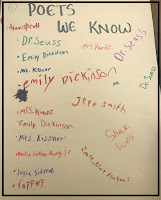This week I started teaching my poetry unit, which is both exciting and scary! It's exciting because I love poetry, and I love the chance to immerse my students in poems. It's scary because each year is so different from the last and I never know how students will react.
Prepare or find a poetry collection
 To immerse students in poems, it's good to have a collection of poetry that they can refer back to, again and again. I have one put together in Figurative Language PowerPoint and Activities. This year, I added two sonnets (available here) to my existing collection.
To immerse students in poems, it's good to have a collection of poetry that they can refer back to, again and again. I have one put together in Figurative Language PowerPoint and Activities. This year, I added two sonnets (available here) to my existing collection.Putting together a poetry collection can be as simple as gathering poems that you want to teach! By adding poems with similar themes, you can invite natural comparisons. Some of my favorites that are in the public domain include:
-The Wind, Robert Louis Stevenson
-Who Has Seen the Wind? Christina Rossetti
-The Moon's the North Wind's Cookie, Vachel Lindsay
-Perhaps You'd Like to Buy a Flower? Emily Dickinson
-Where Go the Boats? Robert Louis Stevenson
-Paper Boats, Rabindranath Tagore
In addition to the poetry collection (mostly made up of public domain poems), I also have shelves full of diverse poetry, picture books that I've picked up from prowling used book sales and the reduced price sections at discount bookstores. These poems give students windows into worlds beyond.

Find out what students already know
It's important to get an idea of what experiences students are bringing with them to the poetry experience. This year, I learned about their prior experiences with a carousel activity. I made six small posters with topics:-Famous Poets
-Figurative Language
-How I Feel About Poetry
 -Poems I Know
-Poems I Know-Speaker in Poetry
-Poetic Structure
Then, students moved from poster to poster in small groups. Let me tell you, I learned so much from watching students and listening to their conversations! From the "Figurative Language" poster I observed that students can generate names of some kinds of figurative language, but that there is some confusion between figurative language and other literary devices. From the "Poets We Know" poster I saw that students couldn't really generate a list of poets, but that my name was on there. :)
Use visuals
Animated and illustrated versions of poems are so engaging! On the first day, we looked at "Ozymandias" and watched this amazing version.Then we talked about what the poem might mean. First conversations with big poems need to be open and nonthreatening, focused less on getting right answers and more on talking about what big ideas might be lurking beneath the words. Don't worry if you don't know what meanings are lurking beneath the words! It can be a joint voyage of discovery.
On a less dramatic note, I also shared this poem that I read aloud. We talked about how the poem makes us feel calm and peaceful...a great entry into deeper discussions of tone and mood.
 Give students the words to discuss
Give students the words to discuss
Great conversations need lots of words! This Poetry Help Sheet (available in Comparing Texts 2) is a quick and easy tool for students to use to have discussions. As an end to our second day of poetry, students read the help sheet and used words from the page to talk about one of the poems in their collection. What is so important is that students are in control of choosing the poems and deciding how to talk about them.
Of course students had questions about these words and topics, which led to even more interesting conversations...for example, what does whimsical mean, anyway?
First experiences with poetry can make all the difference in whether students enjoy poems or look at poetry as a chore. By making your first lessons open-ended and engaging, you can help students love poetry!


No comments:
Post a Comment